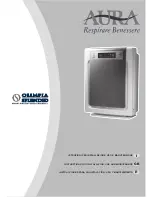
–49–
(2)
Refrigerant Volume Adjustment Operation
1) Operating Characteristics Refrigerant Volume
Characteristic items related to operating characteristics and the refrigerant volume are shown below.
If the number of indoor units in operation increases during cooling, the required volume of refrigerant tends to
increase (the amount of refrigerant in the accumulator tends to decrease), but the change is minimal.
The liquid level in the accumulator is at its highest when all the indoor units are operating during heating.
If there is refrigerant in the accumulator, even if the volume of refrigerant is increased or decreased, there is practi-
cally no change in the outlet temperature.
During cooling, the discharge temperature rises more easily when there is an
overload than when the temperature is low.
During heating, the discharge temperature rises more easily when the tempera-
ture is low than when there is an overload.
The lower the operating frequency, the less efficient the compressor is, making it
easier for the discharge temperature to rise.
The compressor shell temperature becomes 20~70 (36~126) deg. higher than the low pressure saturation tempera-
ture (TH2) if the refrigerant volume is appropriate. If the difference with the low pressure saturation temperature
(TH2) is 10 (18) deg. or less, it can be judged that the refrigerant is overcharged.
2) Adjusting and Judging the Refrigerant Volume
1
Symptoms
Overcharging with refrigerant can be considered as the cause of the following symptoms. When adjusting the
refrigerant volume, be sure that the unit is in the operating condition, and carry out refrigerant volume judgment and
self-diagnosis by the LED’s, judging overall whether the volume of refrigerant is in excess or is insufficient. Perform
adjustments by running the unit in the refrigerant volume adjustment mode.
2
Refrigerant Volume
a
Checking the Operating Condition
Operate all the indoor units on cooling or on heating, checking the discharge temperature, sub-cooling, low pres-
sure saturation temperature, inlet temperature, shell bottom temperature, liquid level, liquid step, etc. and rendering
an overall judgment.
1
2
3
4
5
Tendency of
discharge
Temperature
Comparison
when control is
included.
Emergency stop occurs when the remote control display is at 1500 (refrigerant
overcharge).
The operating frequency doesn’t rise high enough and capacity is not achieved.
Emergency stop occurs when the remote control display is at 1102 (outlet
temperature overheating).
Emergency stop occurs when the remote control display is at 1501 (insufficient
refrigerant).
1
2
3
4
Refrigerant overcharge
Insufficient refrigerant
Insufficient refrigerant
Judgement
Refrigerant volume tends toward
insufficient.
Rifrigerant volume tends toward
overcharge.
Condition
1
Outlet temperature is high. (125
°
C (257˚F) or higher)
2
Low pressure saturation temperature is extremely low.
3
Inlet superheating is high (if normal, SH = 20 (36) deg or lower).
4
Shell bottom temperature is high (the difference with the low pressure saturation
temperature is 70 (126) deg. or greater)
5
Shell temperature is low (the difference with the low pressure saturation tem-
perature is 10 (18) deg. or lower).
6
Dischange superheating is low (if normal, SH = 20 (36) deg or higher).
Note : ˚C Scale (˚F Scale)
Note : ˚C Scale (˚F Scale)
Содержание PURY-100TMU
Страница 8: ... 7 Controller Box ...
Страница 11: ... 10 G A board CNIPM1 CN15V1 CNDR1 CNE CNDC1 Power board ...
Страница 12: ... 11 BC controller CNTR CN02 M NET transmission CN03 CN12 Power supply 1 EARTH 3 N 5 L SW4 SW2 SW1 SW5 ...
Страница 13: ... 12 RELAY 10 board RELAY 4 board ...
Страница 14: ... 13 2 Refrigerant Circuit Diagram and Thermal Sensor ...
Страница 15: ... 14 3 Electrical Wiring Diagram 1 MC P N ...
Страница 17: ... 16 3 CMB 108 1010NU F ...
Страница 18: ... 17 4 CMB 1013 1016NU F ...
Страница 71: ... 70 Motor Compressor G A board Red U V W N P White Blue Blue Capacitor C1 Red IPM ...
















































